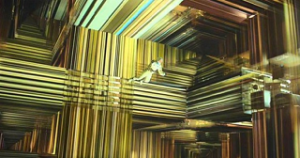
The spiritual in art, almost forgotten
In addition to Kandinsky, a contemporary recognized as having influence in spiritual art, there are three others almost forgotten: Raymond de Sebonde, author of Natural Theology; Gaudí, creator of the Mediterranean Gothic, and Salvador Dali, incorrectly seen as paranoid-critic, see this in sequence.
Mediterranean Gothic, and Salvador Dali, incorrectly seen as paranoid-critic, see this in sequence.
Dali said after a long phase that he himself said he had a psychological and indirect influence of Freud, to integrate into a new phase, where his frame Christus Hypercubus will be a landmark, and may even relate contemporaneousness with Quantum Physics, the fourth dimension of the universe (the Hypercube), and to a certain extent to the tesseract of Charles H. Hilton.
He says in his Anti-matter Manifesto he writes in all letters: “In the surrealist period, I wanted to create the iconography of the inner world and the wonderful world, of my father Freud … Today, the outside world and that of physics transcended the world of psychology, he declair: “My father today is dr. Heisenberg”, so is a Dali post-surrealism as he proclaims himself.
We have already posted something about this before, but we have developed a little more here.
Proclaimed Dali about his work: “I Dali, re-updating Spanish mysticism, I will prove with my work the unity of the universe, showing the spirituality of all substances,” in which the use of substance is not by chance, even of the physical universe, but may also be that which Teilhard Chardin called the “Christocentric universe,” that is, his Noosphere in the most substantial sense of the word, or in the physical sense of the universe.
This dimension, besides being studied in Particle Physics and Astrophysics, appeared in films like “Contact” (1997, direction of Robert Zemeckis) based on the work of the same name of Carl Sagan, and recently the film Interstellar (direction of Christopher Nolan , 2014), and the possibility of the fourth dimension and the universe being immersed in a hypercube is scientific.
Einstein had predicted a relativistic phenomenon Lense-Thirring (homage to Josef Lense and Hans Thirring) that remained for a long time without proof until this effect began to be detected in artificial satellites and since then has been studied as a real possibility, is a effect of a gyroscope due to the gravitational magnetic field.
The Artefacto 2018 event will begin tomorrow in Lisbon, at Palácio da Ceia, among other works, and will present an Ode to Christus Hypercubs by Dr. Jônatas Manzolli from Unicamp, which will feature pianist Helena Marinho from Aveiro and the soloist Beatriz Maia.









